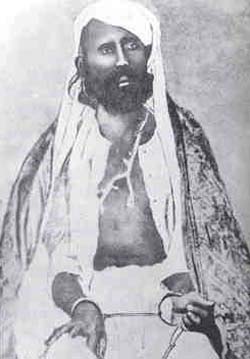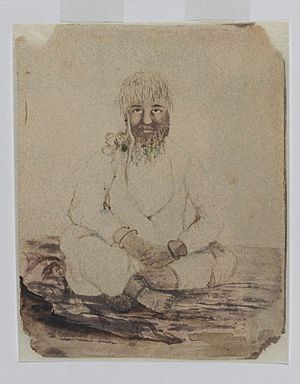Tatya Tope facts for kids
Quick facts for kids
Tatya Tope
|
|
|---|---|

Tantya Tope after his capture in 1859
|
|
| Born |
Ramchandra Panduranga Yawalkar
16 February 1814 |
| Died | 18 April 1859 (aged 45) |
| Cause of death | Execution by hanging |
| Monuments | Tatya Tope Memorial |
| Other names | Ramachandra Panduranga Yewalkar |
| Movement | Indian Rebellion of 1857 |
Tantia Tope (also spelled Tatya Tope) was a very important leader in the Indian Rebellion of 1857. He was born on February 16, 1814, and passed away on April 18, 1859.
His birth name was Ramachandra Panduranga Yewalkar. He was born in Yeola, near Nasik, in a Marathi family. The name "Tope" means "commanding officer," and "Tantia" means "General."
Tantia Tope was a close supporter of Nana Saheb of Bithoor. He led the Gwalior army after the British took back Kanpur. He even forced General Windham to leave the city. Later, Tantia Tope helped Rani Lakshmibai of Jhansi. Together, they took control of the city of Gwalior. However, he was defeated by British Indian troops and had to stop his fight.
People described Tantia Tope as a man of average height with a fair skin tone. He always wore a white turban. The British government executed him in Shivpuri on April 18, 1859.
Contents
Tatya Tope's Role in the 1857 Rebellion
When the rebellion began in Kanpur on June 5, 1857, Nana Saheb became the leader of the rebels. After the British forces in Kanpur gave up, Nana was declared a leader in late June. Nana's troops had to move back to Bithur after a defeat. Tantia Tope then started acting on behalf of Nana Saheb from Bithur.
Tantia Tope was involved in the events at Kanpur in June 1857. He held a strong defensive position until the British forces pushed him out on July 16, 1857. Later, he defeated General Cyrill in the Second Battle of Cawnpore. This battle started on November 19, 1857, and lasted for seventeen days. However, Tope and his army were defeated when the British fought back under Sir Colin Campbell. Tope and other rebels escaped and found safety with the Rani of Jhansi, whom he also helped.
Fighting Alongside Rani Lakshmibai
Tantia Tope and Rao Saheb helped Rani Lakshmibai escape during a British attack on Jhansi. Together with Rani Lakshmibai, they captured Gwalior Fort. They declared it a "Free Kingdom" (Hindavi Swaraj) under the name of Nana Saheb Peshwa.
After losing Gwalior to the British, Tope and Rao Saheb, who was Nana Saheb's nephew, fled to Rajputana. Tantia Tope was able to convince the army of Tonk to join him.
Tope could not enter the town of Bundi. He announced he would go south but actually headed west towards Nimach. A British army led by Colonel Holmes was chasing him. The British commander in Rajputana, General Abraham Robert, attacked the rebel forces between Sanganer and Bhilwara. Tope escaped again and went towards Udaipur. After visiting a Hindu temple on August 13, he gathered his forces by the Banas River. They were defeated again by Roberts's forces, and Tope fled once more. He crossed the Chambal River and reached the town of Jhalrapatan.
Continuing the Fight as a Guerrilla
Even after the main rebellion of 1857 was stopped by the British, Tantia Tope continued to fight. He became a guerrilla fighter, hiding and fighting in the jungles. He encouraged local state forces to rebel against their rulers. He also managed to get new artillery to replace what he had lost.
Tope then led his forces towards Indore. However, the British, now led by General John Michel, chased him as he fled towards Sironj. Tope and Rao Saheb decided to split their forces. Tope went to Chanderi with a larger group, and Rao Saheb went to Jhansi with a smaller one. But they joined up again in October and faced another defeat at Chhota Udaipur.
By January 1859, they reached the state of Jaipur and suffered two more defeats. At this point, Tantia Tope met Man Singh, the Raja of Narwar. He decided to stay at Man Singh's court. Man Singh was having problems with the Maharaja of Gwalior. The British made a deal with Man Singh: if he handed over Tope, his own life and family would be safe. After this, Tope was given to the British and faced his fate.
Tatya Tope's Execution
Tantia Tope admitted to the accusations against him. However, he stated that he was only answerable to his master, the Peshwa. He was executed by hanging on April 18, 1859, in Sipri.
See also


